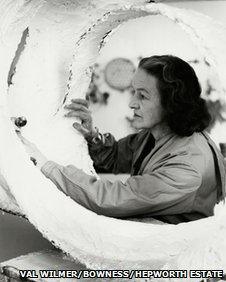The Hepworth: Is our love of modern art here to stay?
- Published
- comments
The BBC's arts editor Will Gompertz went for a sneak preview inside the Hepworth
The Hepworth in Wakefield, external is the latest modern art gallery to be built in Britain.
It joins Middlesbrough, Eastbourne, Gateshead, Margate and Nottingham on the list of places with snazzy new art houses.
There are many others across the country that have either been completely refurbished or greatly expanded. So what are we witnessing: a fad or the future?
I suspect the latter. Britain has not always been pro-modern art. The papers used to sneer while the public would jeer. "Call that art" was the general refrain. Now the reverse is true, we don't seem to be able to get enough of the stuff.
Why? Well one reason is that all these modern art galleries have helped introduce the subject to a much wider audience, often in a way and within an environment that is friendly and welcoming.
Big draw
The idea that artists have spent the past 100 years hood-winking us has dissipated, to be replaced by an intellectual engagement with their work that many find rewarding.

Barbara Hepworth is thought of as one of the great artists of the 20th Century
And because modern art is an ongoing story, with each new chapter bringing fresh ideas as well as adding context to the past, I think our involvement with the subject will increase not decrease.
Take the recently opened Turner Contemporary in Margate for example (designed by David Chipperfield as is The Hepworth). I wrote about it in February having had an early preview.
I was captivated by Chipperfield's architecture. The post received several comments, many unhappy about the money lavished on the project.
The gallery received 70,000 visitors in its first month. That's extraordinary. One thousand people a day are currently visiting the place - twice the budgeted figure for this period.
Sure the numbers might slide, but then that's what people said about Tate Modern. With good management and an imaginative programme I expect Turner Contemporary will still be going strong this time next year.
Look at Nottingham Contemporary. It opened at the end of 2009 and continues to big a big draw, even with its uncompromisingly avant-garde programme.
'Withered and snapped'
The local council reckon it was responsible for bringing £8.7m into the local economy, while also providing a significant educational resource to the city and adding an internationally recognised attraction.
Which is why although they are expensive to build and costly to run, such cultural buildings are seen as an ace in the pack when it comes to urban regeneration.
It's certainly the thinking behind The Hepworth, which should also succeed. Not only is it another excellent building (not quite as magical as Turner Contemporary in my view) but it also has the advantage of a stellar permanent collection of Dame Barbara Hepworth's sculptures.
Some of which has come from the now defunct Wakefield Gallery, but many others have come from St Ives in Cornwall where the Wakefield-born Hepworth settled after a spell in London.
These works are fabulous and fascinating and have been seen by very few people. I was lucky to do some years ago.
The new Wakefield gallery showcases the work of Dame Barbara Hepworth
They consist of a collection of 44 plaster and aluminium sculptures, external that were hidden away from the public in an old cinema in St Ives called the Palais de Danse.
Barbara Hepworth bought the Palais in 1961 having outgrown her studio over the road (which has since been transformed into the Barbara Hepworth Museum and Sculpture Garden, external).
She did little to change the Palais. The dance floor was still there, so was the stage upon which the cinema screen was mounted.
On the floor was the outline of one her most famous sculptures - Single Form, external, which she made for the United Nations building in New York in 1961-64. It was a striking sight.
Not only the scale of the sculpture (it was her largest work) but also the stark reminder of the physicality of her work.
It conjured a picture of the petite Hepworth standing, kneeling and stooping over the work, worrying away at it until she felt it was finished. The other plaster sculptures had the same effect.
They were just sitting on the floor, dusty and chipped, not the perfect and polished examples that are now in The Hepworth.
The strings she famously used to give a sense of tension and materiality to her art had mostly withered or snapped, paint had chipped and cracks had developed.
Their poor condition gave a real sense of them having been made by a human and not a machine: the carving scars prominent and proud, the result of a determined assault on the material to give it vitality and life.
I have long thought it a shame that these almost primal works were not on view to the public.
Barbara Hepworth is one of the great artists of the 20th Century and these plaster sculptures give a particular insight into how she worked. I'm delighted they are now on public view.